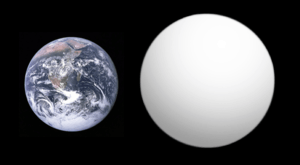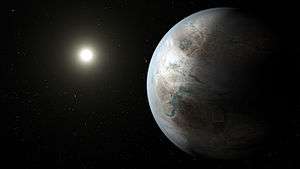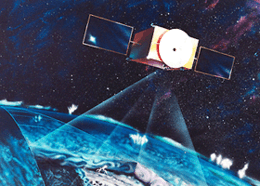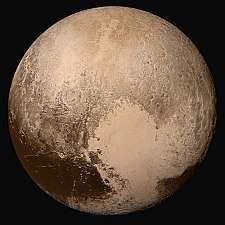K2-3d
| Exoplanet | List of exoplanets | |
|---|---|---|
 | ||
| Parent star | ||
| Star | K2-3 | |
| Constellation | Leo[1] | |
| Right ascension | (α) | 11h 29m 20.3918s[2] |
| Declination | (δ) | −01° 27′ 17.280″[2] |
| Apparent magnitude | (mV) | 12.168±0.009[3] |
| Distance | 143.9±0.4[2] ly (44.1±0.1[2] pc) | |
| Spectral type | M0V | |
| Mass | (m) | 0.612 (± 0.086)[4] M☉ |
| Radius | (r) | 0.553 (± 0.041)[4] R☉ |
| Temperature | (T) | 3835±70[5] K |
| Metallicity | [Fe/H] | −0.01±0.09[5] |
| Age | ≥1[6] Gyr | |
| Physical characteristics | ||
| Mass | (m) | 2.7+1.2 −0.8[5] M⊕ |
| Radius | (r) | 1.65±0.17[5] R⊕ |
| Stellar flux | (F⊙) | 1.46 ⊕ |
| Density | (ρ) | 1.6+2.1 −1.0[5] g cm−3 |
| Surface gravity | (g) | 2.89+2.39 −1.52 g |
| Temperature | (T) | 282 K (9 °C; 48 °F) |
| Orbital elements | ||
| Semi-major axis | (a) | 0.2097+0.0065 −0.0070[5] AU |
| Eccentricity | (e) | 0.045 (± 0.045)[4] |
| Orbital period | (P) | 44.55764±0.00042[5] d |
| Inclination | (i) | 89.79 (± 0.15)[4]° |
| Time of transit | (Tt) | 2456826.2248±0.0037[5] JD |
| Semi-amplitude | (K) | 0.29+0.34 −0.18[5] m/s |
| Discovery information | ||
| Discovery date | 2015 | |
| Discoverer(s) | ||
| Discovery method | Transit | |
| Discovery site | Kepler Space Observatory | |
| Discovery status | Confirmed[6] | |
| Database references | ||
| Extrasolar Planets Encyclopaedia | data | |
| SIMBAD | data | |
| Exoplanet Archive | data | |
| Open Exoplanet Catalogue | data | |
K2-3d, also known as EPIC 201367065 d, is a confirmed massive solid exoplanet orbiting the red dwarf star K2-3, and the outermost of three such planets discovered in the system. It is located 137 light-years (42 pc) away from Earth in the constellation of Leo.[4][7] The exoplanet was found by using the transit method, in which the dimming effect that a planet causes as it crosses in front of its star is measured. It was the first planet in the Kepler "Second Light" mission to receive the letter "d" designation for a planet. Its discovery was announced in January 2015.[6]
Characteristics
Mass, radius, density and temperature
K2-3d is a super-Earth, meaning it has a mass and radius bigger than Earth's, but smaller than that of the ice giants Uranus and Neptune. It has a surface temperature of 282 K (9 °C; 48 °F) and a radius of 1.51 R⊕. Normally, a planet of this size would be a mini-Neptune, with no solid surface.[8] However, its unusual density when fit for a radius of K2-3d's size would make it an exception to this rule, giving it a solid surface: its density is 11.7±6.7 g/cm3, but may be as high as 17.5±6.3 g/cm3.[4] This is far greater than the density of iron. Because of this, a composition of almost pure iron with some silicate (rocky) mixed in is likely, giving it a mass of around 7.5 M⊕ to 11.1 M⊕.[4] For it to be completely iron, it would have to be 14 times more massive than Earth; however, this is unlikely. The planet's extremely high density indicates that it is a likely candidate for being an Iron planet.
Host star
The planet orbits a (M-type) red dwarf star named K2-3, orbited by a total of three known planets, of which K2-3d has the longest orbital period.[6] The star has a mass of 0.60 M☉ and a radius of 0.56 R☉.[7][6] It has a temperature of 3896 K and is about 1 billion years old.[7] In comparison, the Sun is 4.6 billion years old[9] and has a surface temperature of 5778 K.[10]
The star's apparent magnitude, or how bright it appears from Earth's perspective, is 12.168.[3] Therefore, it is too dim to be seen with the naked eye.
Orbital statistics
K2-3d orbits its host star, which has about 6% of the Sun's luminosity, with an orbital period of 44 days and an orbital radius of about 0.2 times that of Earth (compared to the distance of Mercury from the Sun, which is about 0.38 AU).[7]
Habitability
The planet orbits on the edge of the inner (empirical) habitable zone, a region where, with the proper atmospheric properties and pressure, liquid water may exist on the surface of the planet. However, it is very likely tidally locked to its star, with one side facing towards its star in scorching heat, and the opposite side in bitter darkness.[11] Despite this, there is an area – the terminator line – where the surface temperatures may be comfortable enough to support liquid water. However, given that most models of the habitable zone parameters put K2-3d slightly beyond the inner edge of the habitable zone, it is likely to be too hot even at the terminator line and thus not habitable at all. Plus, the high gravity caused by the density of K2-3d would further hinder its habitability. Also, the stellar flux for the planet is an abnormally high 1.4 times that of Earth,[6] which could result in surface temperatures of up to 400–500 K (127–227 °C; 260–440 °F) because of a runaway greenhouse effect.
Discovery
The planet, along with the other two known planets in the K2-3 system, was announced in early January 2015 as part of the first results from the second mission of the Kepler spacecraft. With this, it was the first multiplanetary system of the mission as well.[6]
See also
References
- ↑ Roman, Nancy G. (1987). "Identification of a Constellation From a Position". Publications of the Astronomical Society of the Pacific. 99 (617): 695–699. Bibcode:1987PASP...99..695R. doi:10.1086/132034. Vizier query form
- 1 2 3 4 Brown, A. G. A.; et al. (Gaia collaboration) (August 2018). "Gaia Data Release 2: Summary of the contents and survey properties". Astronomy & Astrophysics. 616. A1. arXiv:1804.09365. Bibcode:2018A&A...616A...1G. doi:10.1051/0004-6361/201833051. Gaia DR2 record for this source at VizieR.
- 1 2 Henden, A. A.; et al. (2016). "VizieR Online Data Catalog: AAVSO Photometric All Sky Survey (APASS) DR9 (Henden+, 2016)". VizieR On-line Data Catalog: II/336. Originally published in: 2015AAS...22533616H. 2336. Bibcode:2016yCat.2336....0H. Vizier catalog entry
- 1 2 3 4 5 6 7 "K2-3 d CONFIRMED PLANET OVERVIEW PAGE". NASA Exoplanet Archive. Retrieved 2015-10-17.
- 1 2 3 4 5 6 7 8 9 Damasso, M.; et al. (2018). "Eyes on K2-3: A system of three likely sub-Neptunes characterized with HARPS-N and HARPS". Astronomy and Astrophysics. 615. A69. arXiv:1802.08320. Bibcode:2018A&A...615A..69D. doi:10.1051/0004-6361/201732459.
- 1 2 3 4 5 6 7 Crossfield, Ian J. M.; et al. (2015). "A Nearby M Star with Three Transiting Super-Earths Discovered by K2". The Astrophysical Journal. 804 (1). 10. arXiv:1501.03798. Bibcode:2015ApJ...804...10C. doi:10.1088/0004-637X/804/1/10.
- 1 2 3 4 "The Extrasolar Planet Encyclopaedia — K2-3 d".
- ↑ "Most 1.6 Earth-radius planets are not rocky". 31 July 2014.
- ↑ Fraser Cain (16 September 2008). "How Old is the Sun?". Universe Today. Retrieved 19 February 2011.
- ↑ Fraser Cain (15 September 2008). "Temperature of the Sun". Universe Today. Retrieved 19 February 2011.
- ↑ http://www.hpcf.upr.edu/~abel/phl/hec_plots/hec_orbit/hec_orbit_K2-3_d.png


